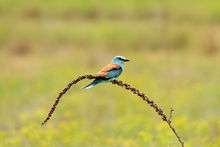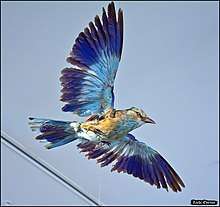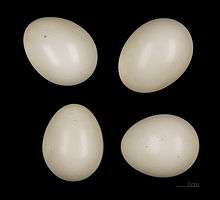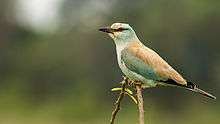European roller
| European roller | |
|---|---|
 | |
| Adult with a centipede | |
| Scientific classification | |
| Kingdom: | Animalia |
| Phylum: | Chordata |
| Class: | Aves |
| Order: | Coraciiformes |
| Family: | Coraciidae |
| Genus: | Coracias |
| Species: | C. garrulus |
| Binomial name | |
| Coracias garrulus | |
| Subspecies | |
| |
 | |
| Distribution of the European roller summer C. g. garrulus summer C. g. semenowi winter | |
The European roller (Coracias garrulus) is the only member of the roller family of birds to breed in Europe. Its overall range extends into the Middle East, Central Asia and Morocco.
The European roller is found in a wide variety of habitats, avoiding only treeless plains. It winters primarily in dry wooded savanna and bushy plains, where it typically nests in tree holes.
Taxonomy and systematics
The rollers are medium-sized Old World birds of open woodland habitats. They have brightly coloured plumage and a hooked bill. Most are found south of the Sahara. The genus Coracias contains eight species of sit-and-wait hunters. The European roller is similar in appearance and behaviour to the Abyssinian roller, which appears to be its closest relative. These two birds and the lilac-breasted roller seem to share a common ancestry and could possibly be considered to form a subspecies.[2]
The European roller was described by Linnaeus in his Systema naturae in 1758 under its current name.[3] The genus name derives from Greek; korakias refers to a type of crow, perhaps the red-billed chough.[4] The species garrulus is from Latin and means chattering or noisy.[5] Alternate names include the blue roller, common roller, Eurasian roller, or simply roller.
Subspecies
There are two subspecies recognised:[6]
- Western European roller (C. g. garrulus) - Linnaeus, 1758: The nominate subspecies. Found in north-western Africa, Europe and east through north-western Iran to south-western Siberia.[7]
- Eastern European roller (C. g. semenowi) - Loudon & Tschusi, 1902:[8] Also named the Kashmir roller. Found in Iraq and southern Iran east through Kashmir and southern Kazakhstan to Xinjiang in western China.[7]
Description



The European roller is a stocky bird, the size of a jackdaw at 29–32 cm in length with a 52–58 cm wingspan; it is mainly blue with an orange-brown back. Rollers often perch prominently on trees, posts or overhead wires, like giant shrikes, whilst watching for the large insects, small reptiles, rodents and frogs that they eat.
This species is striking in its strong direct flight, with the brilliant blue contrasting with black flight feathers. Sexes are similar, but the juvenile is a drabber version of the adult.
The display of this bird is a lapwing-like display, with the twists and turns that give this species its English name. It nests in an unlined tree or cliff hole, and lays up to six eggs.
The call is a harsh crow-like sound. It gives a raucous series of calls when nervous.
Distribution and habitat
The European roller is a bird of warmer regions. The nominate subspecies breeds in northern Africa from Morocco to Tunisia, in southern and east-central Europe, and eastwards through northwestern Iran to southwestern Siberia. The subspecies C. g. semenowi breeds from Iraq and southern Iran east through Kashmir and southern Kazakhstan to Xinjiang. The European range was formerly more extensive, but there has been a long-term decline in the north and west, with extinction as a nesting bird in Sweden and Germany. The European roller is a long-distance migrant, wintering in Sub-Saharan Africa in two distinct regions, from Senegal east to Cameroon and from Ethiopia west to Congo and south to South Africa.[7] Some populations migrate to Africa through India. A collision with an aircraft over the Arabian Sea has been recorded.[9][10]

It is a bird of warm, dry, open country with scattered trees, preferring lowlands, but occur up to 1000 m (3300 ft) in Europe and 2000 m (6600 ft) in Morocco. Oak and pine woodlands with open areas are prime breeding habitat, but farms, orchards and similar areas with mixed vegetation are also used. In Africa, a similarly wide range of dry open land with trees is used.[7] It winters primarily in dry wooded savanna and bushy plains, where it typically nests in tree holes.
Defence
The European Roller chick will vomit a foul-smelling orange liquid onto itself to deter a predator. The smell also warns the parents on their return to the nest.[11]
Migration
The advent of sufficiently lightweight tracking technology has facilitated several recent studies of roller migration, providing new information on the non-breeding sites used by rollers from different breeding populations. Individuals from south-west European populations migrate to south-west Africa (Angola, Namibia, Botswana), with French and north-Spanish birds taking a direct southerly route across the Sahara and Portuguese and south-Spanish taking a more westerly route around the west African coast.[12][13][14] Rollers from eastern European populations also spend the winter period in southern Africa, but further east in Zambia, Zimbabwe, Botswana. The Sahel savannah region immediately south of the Sahara Desert (particularly the area around Lake Chad) appears to be important for rollers from many populations as an autumn re-fuelling site, and Latvian and other north and north-eastern populations migrate northwards via the Arabian Peninsula in spring.[15][16] Individuals from different breeding populations use distinct but overlapping winter sites; there is a good correlation between the longitude of individual breeding and non-breeding sites, suggesting parallel migration. In the east, the northernmost breeders (from Latvia) tend to winter south of the southernmost breeders (from Cyprus) - this suggests a pattern of 'leap-frog' migration.[15]
Status
The Eurasian roller has an extensive distribution in Europe and western Asia, and its European breeding population is estimated at 159,000 to 330,000 birds. When Asian breeders are added, this gives a global total population of 277,000 to 660,000 individuals. There have been fairly rapid population declines across much of its range, so it was formerly classified as Near Threatened by the International Union for Conservation of Nature in 2005; it has however, been downlisted to Least Concern in 2015, as population development was judged to not meet the criteria for a more urgent rating at this time.[1] The European population declined by 25 percent between 1990 and 2000. The northern areas of the breeding range have fared worst, with numbers in the Baltic states and northern Russia collapsing, and no birds left breeding in Estonia.[1]
Threats include hunting while on migration in around the Mediterranean, and large numbers, possibly in the thousands, are killed for food in Oman. Agricultural practices have led to the loss of trees and hedges which provide potential nest sites and perches for hunting, and pesticides have reduced the availability of insect food.[1]
References
- 1 2 3 4 BirdLife International (2017). "Coracias garrulus". The IUCN Red List of Threatened Species. IUCN. 2017: e.T22682860A111884908. doi:10.2305/IUCN.UK.2017-1.RLTS.T22682860A111884908.en. Retrieved 14 January 2018.
- ↑ Hoyo, Josep del; Elliott, Andrew; Sargatal, Jordi; Christie, David A (eds.). "Coraciidae". Handbook of the Birds of the World Alive. Lynx Edicions. Retrieved 10 September 2013. (subscription required).
- ↑ Linnaeus (1758) p. 107.
- ↑ Jobling (2010) p. 117
- ↑ Jobling (2010) p. 171.
- ↑ Hoyo, Josep del; Elliott, Andrew; Sargatal, Jordi; Christie, David A (eds.). "European Roller". Handbook of the Birds of the World Alive. Lynx Edicions. Retrieved 23 November 2013. (subscription required)
- 1 2 3 4 Fry et al. (1992) pp. 298–300.
- ↑ Loudon, Harald von Freiherr; von Tschusi zu Schmidhoffen, Viktor (1902). "Coracias garrulus semenowi Loudon & Tschusi nov. Subsp.". Ornithologisches Jahrbuch (in German). 13 (3, 4): 148–150.
- ↑ Satheesan, S M (1990). "Bird-aircraft collision at an altitude of 2424 m over the sea". Journal of the Bombay Natural History Society. 87 (1): 145–148.
- ↑ Catry, Inês; Catry, Teresa; Granadeiro, José Pedro; Franco, Aldina M. A.; Moreira, Francisco (25 June 2014). "Unravelling migration routes and wintering grounds of European rollers using light-level geolocators". Journal of Ornithology. 155 (4): 1071–1075. doi:10.1007/s10336-014-1097-x.
- ↑ ""Vomit Bird" Throws Up a Defense Against Predators". Discovery News. Discovery Channel. Retrieved 13 October 2014.
- ↑ Emmenegger, Tamara; Mayet, Patrick; Duriez, Olivier; Hahn, Steffen (8 November 2013). "Directional shifts in migration pattern of rollers (Coracias garrulus) from a western European population". Journal of Ornithology. 155 (2): 427–433. doi:10.1007/s10336-013-1023-7.
- ↑ Catry, Inês; Catry, Teresa; Granadeiro, José Pedro; Franco, Aldina M. A.; Moreira, Francisco (2014-10-01). "Unravelling migration routes and wintering grounds of European rollers using light-level geolocators". Journal of Ornithology. 155 (4): 1071–1075. doi:10.1007/s10336-014-1097-x. ISSN 2193-7192.
- ↑ Rodríguez-Ruiz, Juan; Puente, Javier de la; Parejo, Deseada; Valera, Francisco; Calero-Torralbo, Miguel A.; Reyes-González, José M.; Zajková, Zuzana; Bermejo, Ana; Avilés, Jesús M. (2014-12-31). "Disentangling Migratory Routes and Wintering Grounds of Iberian Near-Threatened European Rollers Coracias garrulus". PLOS ONE. 9 (12): e115615. doi:10.1371/journal.pone.0115615. ISSN 1932-6203.
- 1 2 Finch, Tom; Saunders, Philip; Avilés, Jesús Miguel; Bermejo, Ana; Catry, Inês; de la Puente, Javier; Emmenegger, Tamara; Mardega, Ieva; Mayet, Patrick (2015-09-01). "A pan-European, multipopulation assessment of migratory connectivity in a near-threatened migrant bird". Diversity and Distributions. 21 (9): 1051–1062. doi:10.1111/ddi.12345. ISSN 1472-4642.
- ↑ Finch, Tom; Dunning, Jamie; Kiss, Orsolya; Račinskis, Edmunds; Schwartz, Timothée; Sniauksta, Laimonas; Szekeres, Otto; Tokody, Béla; Franco, Aldina (2017-01-01). "Insights into the migration of the European Roller from ring recoveries". Journal of Ornithology. 158 (1): 83–90. doi:10.1007/s10336-016-1374-y. ISSN 2193-7192.
Cited texts
- Fry, C Hilary; Fry, Kathie; Harris, Alan (1992). Kingfishers, Bee-eaters and Rollers. London: Helm. ISBN 0-7136-8028-8.
- Jobling, James A (2010). The Helm Dictionary of Scientific Bird Names. London: Christopher Helm. ISBN 978-1-4081-2501-4.
- Linnaeus, Carl (1758). Systema naturae per regna tria naturae, secundum classes, ordines, genera, species, cum characteribus, differentiis, synonymis, locis. Tomus I. Editio decima, reformata (in Latin). Holmiae: Laurentii Salvii.
External links
![]()
- European roller - Species text in The Atlas of Southern African Birds.
- European roller videos, photos & sounds on the Internet Bird Collection
- Oiseaux Photos
- Ageing and sexing (PDF; 4.5 MB) by Javier Blasco-Zumeta & Gerd-Michael Heinze

